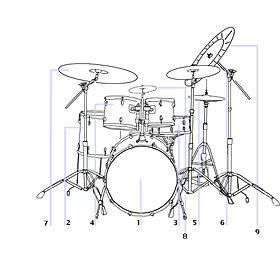Cowbells

Cowbell
|
|
| Percussion instrument | |
|---|---|
| Classification | hand percussion |
| Hornbostel–Sachs classification | 111.242.111 (Externally struck percussive idiophone) |
| Playing range | |
| Single note with timbral variations | |
| Related instruments | |
| Agogô | |
| The drum kit |
|
| Not shown |
|
| See also |
The cowbell is an idiophone hand percussion instrument used in various styles of music including salsa and infrequently in popular music. It is named after the similar bell historically used by herdsmen to keep track of the whereabouts of cows.
While the cowbell is commonly found in musical contexts, its origin can be traced to freely roaming animals. In order to help identify the herd to which these animals belonged, herdsmen placed these bells around the animal's neck. As the animals moved about the bell would ring, thus making it easier to know of the animal's whereabouts. Though the bells were used on various types of animals, they are typically referred to as "cowbells" due to their extensive use with cattle.
Tuned cowbells or Almglocken (their German name), sometimes known by the English translation alpine bells (also in German), typically refer to bulbous brass bells that are used to play music, sometimes as a novelty act or tourist attraction in the northern Alps, and sometimes in classical music, as in Richard Strauss's Alpine Symphony. Since they are tuned differently, in order to distinguish individual animals, they can be collected "from the pasture" in random tunings, but commercial sets in equal temperament are also available. The metal clapper is retained, and they sound much more noisy than handbells, which are otherwise used similarly in ensembles.
Composers who included Almglocken among their musical palette include Tōru Takemitsu, Jo Kondo, Gustav Mahler, Richard Strauss, Roy Harter, John Adams, Joseph Schwantner, and . Olivier Messiaen used multiple chromatic sets of clapperless cowbells in several of his compositions, notably Et expecto resurrectionem mortuorum and Couleurs de la cité celeste.
...
Wikipedia


